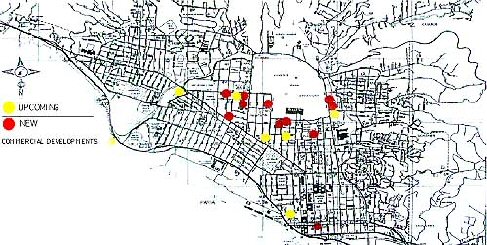| Downtown losing its appeal
Published
Thursday 1st July, 2004
Last week we looked at some of the
effects of the present wave of commercial migration on the capital and
this week we will conclude by examining the major upcoming developments
in Port-of-Spain.

The map sets out the new commercial
offices on the fringes of the downtown area and the ones now under
construction or in the late planning stages.
It is clear that the downtown area has
lost its appeal and that the “centre of gravity” of the city has indeed
shifted away from its traditional core.
Of course, the dispersed pattern of the
new developments would seem to challenge the very idea that our capital
city even has a single such centre any more.
The growing wealth of the business class,
the present low interest rates and the consequent attractiveness of
property investment have all acted to spur the wave of investment we are
witnessing. How will these trends impact on the quality of life in our
capital city?
The answer to this question would emerge
from these points:
Traffic
The main feature of PoS, for those who
have to live and work there, is the constant and growing level of
traffic, together with the difficulty in finding safe, affordable
parking.
The latest study by Udecott estimates
that up to 500,000 people travel into and out of the city every working
day.
There have been no new roads since the
construction of the Audrey Jeffers Highway (the Foreshore) about 20
years ago and one wonders how much worse can the traffic get? The queues
from the West, East and Maraval show no sign of decreasing.
Ironically, many of the new businesses in
the fringes of the city moved there to escape the heavy traffic and
parking problems of downtown and these are now becoming serious issues
in the new locations due to inadequate planning.
Given the number and scale of the
upcoming developments, what can we do to limit the predictable impact of
traffic in the future?
There have been long-standing proposals
for the introduction of parking meters in downtown PoS; will such a
scheme have the desired effect of reducing private car traffic into the
city? How will the growing traffic issue in the fringes be handled?
Waterfront spaces
We are unique amongst waterfront/port
cities in having no attractive, public spaces where this amenity can be
enjoyed.
The only two public waterfront spaces in
the city are very limited; the smelly waters near the lighthouse at
Katanga and the parking area on the said Foreshore.
Until other waterfronts, there are not
the few public facilities, except the benches at Katanga. The waterfront
areas at Cocorite and Westmoorings, west of the city, have been utilised
by private landowners. No public access.
Are there any proposals for the creation
of these kinds of amenities? Will we learn from the errors of the past
and begin to trade reclamation rights for public access rights in the
future?
The proposals for the redevelopment of
the King’s Wharf area in San Fernando would seem to be an opportunity to
try that approach.
Udecott’s proposals
For some time now there have been
proposals for the redevelopment of the PoS waterfront into an
office/commercial complex. We have heard of the new Customs & Excise,
Board of Inland Revenue buildings and the ACS headquarters to be located
at the Richmond Street site.
The State seems to be making a concerted
effort to revitalise the fading downtown area with new offices.
The UTC headquarters is a tangible sign
of that effort, but what are we to make of the new FCB HQ and the
proposed Ministry of Health building, both at Queen’s Park East? The
waterfront proposals would have been significantly boosted by the delay
of these uptown schemes until suitable sites were available in the
target area.
To return to the concerns raised above,
it is hoped that the new, ambitious waterfront proposals have public
access as a centerpiece.
Public participation
As we mentioned last week, the
frustration of the Woodbrook residents at their powerlessness is a sign
of the need for stakeholder participation in the city’s development.
Whatever the future of the city and the
scale of the ambitions being played out, it will all be for naught if we
do not have proper sight of the proposals and opportunity to shape
these.
Next week, we will begin to examine the
rapidly-growing city of Chaguanas. |

